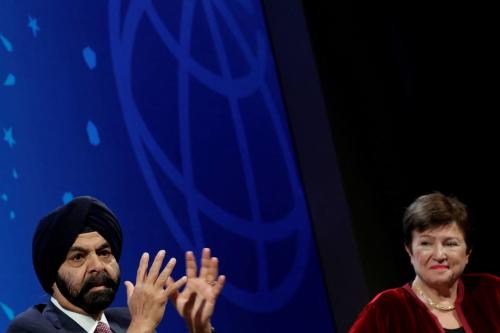Ministers at the IMF-World Bank Development Committee face a profoundly disturbing outlook for aid and development. The new Global Monitoring Report of the World Bank and the IMF says that the world is falling well short of the global development goals set for 2015. What the report implies, but says more discretely, is that the system of development assistance is failing the poor. It is customary to explain away this uncomfortable fact by listing the many reasons why developing countries do not use aid effectively: lack of vision and achievable goals; poor planning and execution of projects, lack of monitoring and accountability resulting in corruption, slow disbursements and ineffective projects. But while enormously important, these explanations deflect attention from what is rapidly becoming an unmanageable aid delivery system, with multiple donors, many fragmented projects, and divided priorities. Although it is fashionable to say there are no “quick” fixes to the structural problems of the aid system, there is an urgency to finding short-term fixes that can have rapid impact. These are simple and widely understood by aid practitioners. But political pressures in donor countries are impeding implementation.
Consider the facts. Official aid disbursements to developing countries accounted for $ 103.7 billion in 2007, falling for the first time in a decade. The OECD calculates that, on the basis of current donor plans, aid in 2010 will short fall of promised amounts by about $38 billion. The quality of aid is also declining. Last year, less than half of the total (i.e. $ 48 billion) was actually available to the developing world to spend on their long-term development needs. The rest went into debt relief (much of which would not have been paid anyway, based on past track records) and other non-programmable items such as technical assistance, food aid, humanitarian relief and donor administrative costs. And studies suggest that half of the amount that is made available does not reach the intended beneficiaries, but leaks out within aid recipient countries. That leaves only $24 billion that potentially affects the lives of the 1 billion poor in this world. When aid is in such short supply, it is vital that the quality of delivery be as high as possible. There are efforts to do this: the Paris Declaration and the UN-led Financing for Development Initiative have broad recommendations to revamp the aid system for greater development impact, but the measures proposed in these initiatives are complex and will take years to implement properly. In the meantime, there are several short-term fixes that development agencies can make now to improve the quality of aid.
First, aid fragmentation must be reduced sharply. According to the World Bank, the average number of donors per country has increased three-fold from 12 in 1960 to 33 in 2005, with some countries hosting more than 40 donors at a time (and each donor has multiple agencies who typically do not coordinate among themselves). The average size of a project has fallen from $ 2.5 million in 1997 to $ 1.5 million in 2004, while the reporting and administrative requirements for aid projects have been going up to try to protect against corruption and to ensure no adverse social and environmental impacts occur. The net effect of this excessive atomization is higher transaction costs and coordination nightmares for both donors and recipients. Ministries in developing countries often assign their best educated staffers to handle donor reports rather than having them actually implement development programs.
This is not necessary. The growth in the number of donors is to be welcomed. More donors mean more aid money. But small donors should be encouraged to pool their resources, not just add new activities. And large donors must reduce their insistence on “my way, or the by-way”. This was recognized years ago and multilateral aid agencies were created to reduce transaction costs by having specialized staff with experience in reviewing and financing aid programs. They should be empowered to do this job. Instead, the share of multilaterals has fallen to its lowest point in recent history; just 8% of all aid flows through the large multilateral development banks. This share should be doubled by 2010. The large donors should lead the way in promoting multilateral leadership rather than undermining it by advancing their own domestic agendas through separate aid programs. Aid is too vital to be politicized to this degree.
Second, the volatility of international aid must be reduced. Studies suggest that official aid flows during the last one and half decade were 4 to 5 times more volatile than the developing countries’ national incomes. Also, aid flows now are 30% more volatile and erratic than they were three decades ago. According to my calculations, this excess volatility diminishes the true value of aid to the recipient countries by about a quarter.
It is inconceivable that donors cannot do a better job of smoothing resource flows to aid recipients. They need to agree on a workable measure of volatility (there are plenty of candidates any of which would suffice) and set targets to bring it down. They can develop new instruments to make aid countercyclical—giving more when recipient government revenues go down if caused by an external shock—rather than contributing to volatility through procyclical disbursements. Every personal financial adviser suggests ways to their clients of reducing volatility. The donors should offer recipient countries a similar menu of options.
Third, more money must be extended to projects and programs that can really make a difference. Far too much aid is now disbursed as “technical assistance” (TA). While some TA is truly valuable and fills a gap in aid recipient country skills sets, other TA can best be described as unsolicited, overinvoiced, and impractical advice. Most of this money never crosses the border to developing countries. It is simply recycled back to rich nations through the salaries of expatriate consultants with very limited capacity building impact in the developing countries.
It is astonishing that the share of technical assistance in net official development assistance has actually risen (from 21% to 26% between the 1970’s and the 2000’s) while that of aid programmed for development projects has fallen (from 68% to 46%). Reversing this trend, and committing to return project and program aid to its traditional share of two-thirds, within five years, would sharply improve aid quality.
Fourth, exploit the capabilities of non-profit aid providers. International non-profits have traditionally been important in disaster relief and humanitarian assistance but less so in development. That has started to change. Within developing countries there has been an explosion of non-profit agencies delivering a variety of development services, often in very cost effective fashion. Many non-profits are large enough and sophisticated enough to be integral players in development assistance, but not enough is being done to take advantage of their skills. In some areas, they already dominate. For instance, about one half of the total microfinance to about 94 million poor is currently provided through non-government players. In health, entrepreneurial development, housing, agriculture and other areas private non-profits have led the way with innovative development programs but are still divorced from public programs in these areas.
The point is that delivery of development programs is no longer the domain of the public sector. The non-profit sector has already shown it can mobilize funds for development–$58-68 billion per year by some estimates. It could do even more if given more opportunity. Official aid donors should systematically develop funding mechanisms that are accessible so that non-profits with grand ideas, established track records but limited resources can scale up their activities to make a real dent in poverty. Some, like BRAC in Bangladesh, have succeeded without such support. Think of how many more budding BRACs could emerge if more of the $100 billion in official aid was easily accessible to them.
Each of the four measures proposed above is quantifiable and measurable targets for improvement can be set. Each depends purely on official donor actions. They can be done, if there is political will. Instead of reiterating promises for more aid, which increasingly ring hollow, the official aid donors could make a material difference to the quality of aid if they committed themselves to specific actions in these areas.



Commentary
Op-edShort Term Fixes for Development Assistance
April 10, 2008